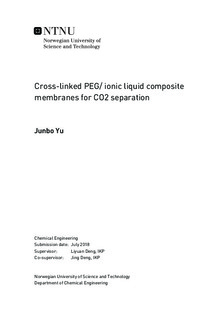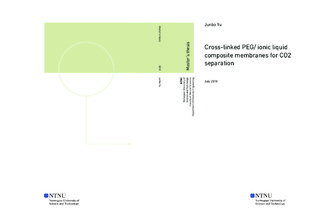| dc.description.abstract | The increasing CO2 emission has become an urgent issue in the past decades. Comparing with other traditional CO2 separation technologies such as amino absorption, membrane separation has been considered as a potential candidate, owing to its negligible pollution, low energy-consumption and low cost. Among the current membrane materials, PEO (polyethylene oxide)-based membranes have recently received a lot of attention due to their high affinity to CO2. In Specialization Project TKP4580, a series of cross-linked PEG-based membrane containing dual cross-linking networks were developed. The object of this work is to further improve the CO2/N2 separation performance by physical blending with four different room temperature ionic liquids ([Bmim][BF4], [Bmim][PF6], [Bmim][Tf2N] and [Bmim][TCM]).
The reaction mechanisms of aza-Michael addition and photo-polymerization which involved in membrane fabrication are confirmed by FT-IR test. The TGA results for the membranes exhibit a slight reduction in thermal stability by the addition of ionic liquids, but still qualify the industrial requirements of post-combustion for CO2 capture. It can be concluded from DSC curves that the ionic liquids are well dispersed inside the membrane matrix and the polymer chains become more flexible. XRD results confirm that the composite membranes are in the amorphous state, and the crystallization is suppressed by IL addition.
The gas separation performance of these four composite membranes was tested by single gas permeation experiments. Results for all composite ionic liquid membranes have shown a decrease in CO2 permeability at the low IL content of 20% and then it increases with the addition of IL up to 80%. On the contrary, CO2/N2 ideal selectivity decreases with an increase in IL content from 0% to 80%. Upper bound was used to evaluate the gas separation performance of all IL-containing composite membranes. Among four ionic liquids, [Bmim][TCM] is the most effective in enhancing the CO2/N2 separation performance (CO2 permeability of 138 Barrer, CO2/N2 selectivity of 45), compared with the neat membrane. | |

